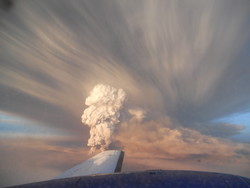Risk assessment of volcanic eruptions
The Icelandic government approved on August 26th a proposal by the Minister for the Environment, Svandís Svavarsdóttir, for the preparation of a general risk assessment regarding volcanic eruptions in Iceland. The proposal was based on an estimate made by the Icelandic Meteorological Office in collaboration with the Civil Protection Department of the National Commissioner of the Icelandic Police, the Institute of Earth Sciences at the University of Iceland, the Soil Conservation Service of Iceland and the Icelandic Road Administration.
Studies indicate that volcanic activity in Iceland rises and falls so that e.g. the frequency and size of eruptions in and around the Vatnajökull ice cap varies with time. It is believed that four eruptions, that have taken place in the last fifteen years, are the beginning of an active period, during which an eruption in Grímsvötn in Vatnajökull may be expected every 2–7 years. Parallel volcanic activity in nearby Bárðarbunga is well known to be associated with increased activity in Grímsvötn. Seismic activity has been increasing in the area in recent years, indicating the entry of magma. The Hekla volcano is expected to erupt in the near future and an eruption in Katla is also impending.
Following the eruptions in Grímsvötn in 2011 and Eyjafjallajökull in 2010, it is evident that an integrated risk assessment for hazard due to volcanic eruptions must be made. An integrated risk assessment consists of an evaluation of potential hazard and the vulnerability of society, followed by an estimate of the corresponding risk and of feasible counter-measures in order to prevent accidents and minimise economic damage.
The work on a general risk assessment will be organized in accordance with the risk assessment framework of the United Nations and the World Meteorological Organization. It is estimated to take 15–20 years to complete and it will require a joint effort by and collaboration with various institutions. The initial three years will focus on the following tasks:
- An appraisal of current knowledge
- Initial assessment of floods related to eruptions
- Initial assessment of explosive eruptions in Iceland
- Initial assessment of volcanic eruption that may cause extensive damage to property, i.e. eruption in the vicinity of urban areas and international airports in Iceland
In addition to the government funding of this project, ISAVIA, the company for air navigation services, the Icelandic Road Administration, and Landsvirkjun, the national power company, supply funding. Other projects such as analysing and categorising volcanic activity in Iceland, funded by the International Civil Aviation Organization, ICAO will as well be beneficial for the risk assessment project.
The Icelandic Meteorological Office is very pleased with the decision of the government. In recent years the institute has stressed the need for a general risk assessment for natural hazards, with the methodology successfully applied in the risk assessment of avalanches and landslides, which has been made according to the risk assessment framework of the World Meteorological Organization and United Nations.




